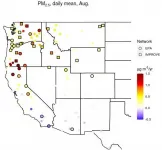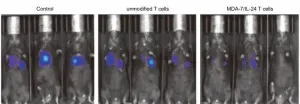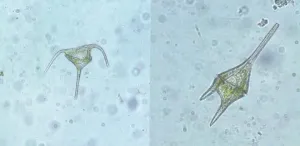Not just for finding planets: Exoplanet-hunter TESS telescope spots bright gamma-ray burst
2021-04-30
(Press-News.org) DALLAS (SMU) - NASA has a long tradition of unexpected discoveries, and the space program's TESS mission is no different. SMU astrophysicist and her team have discovered a particularly bright gamma-ray burst using a NASA telescope designed to find exoplanets - those occurring outside our solar system - particularly those that might be able to support life.
It's the first time a gamma-ray burst has been found this way.
Gamma-ray bursts are the brightest explosions in the universe, typically associated with the collapse of a massive star and the birth of a black hole. They can produce as much radioactive energy as the sun will release during its entire 10-billion-year existence.
Krista Lynne Smith, an assistant professor of physics at Southern Methodist University, and her team confirmed the blast - called GRB 191016A - happened on Oct. 16 and also determined its location and duration. A study on the discovery has been published in The Astrophysical Journal.
"Our findings prove this TESS telescope is useful not just for finding new planets, but also for high-energy astrophysics," said Smith, who specializes in using satellites like TESS (Transiting Exoplanet Survey Satellite) to study supermassive black holes and gas that surrounds them. Such studies shed light on the behavior of matter in the deeply warped spacetime around black holes and the processes by which black holes emit powerful jets into their host galaxies.
Smith calculated that GRB 191016A had a peak magnitude of 15.1, which means it was 10,000 times fainter than the faintest stars we can see with the naked eyes.
That may sound quite dim, but the faintness has to do with how far away the burst occurred. It is estimated that light from GRB 191016A's galaxy had been travelling 11.7 billion years before becoming visible in the TESS telescope.
Most gamma ray bursts are dimmer - closer to 160,000 times fainter than the faintest stars.
The burst reached its peak brightness sometime between 1,000 and 2,600 seconds, then faded gradually until it fell below the ability of TESS to detect it some 7000 seconds after it first went off.
This gamma-ray burst was first detected by a NASA's satellite called Swift-BAT, which was built to find these bursts. But because GRB 191016A occurred too close to the moon, the Swift-BAT couldn't do the necessary follow-up it normally would have to learn more about it until hours later.
NASA's TESS happened to be looking at that same part of the sky. That was sheer luck, as TESS turns its attention to a new strip of the sky every month.
While exoplanet researchers at a ground-base for TESS could tell right away that a gamma-ray burst had happened, it would be months before they got any data from the TESS satellite on it. But since their focus was on new planets, these researchers asked if any other scientists at a TESS conference in Sydney, Australia were interested in doing more digging on the blast.
Smith was one of the few high-energy astrophysics specialists there at that time and quickly volunteered.
"The TESS satellite has a lot of potential for high-energy applications, and this was too good an example to pass up," she said. High-energy astrophysics studies the behavior of matter and energy in extreme environments, including the regions around black holes, powerful relativistic jets, and explosions like gamma-ray bursts.
TESS is an optical telescope that collects light curves on everything in its field of view, every half hour. Light curves are a graph of light intensity of a celestial object or region as a function of time. Smith analyzed three of these light curves to be able to determine how bright the burst was.
She also used data from ground-based observatories and the Swift gamma-ray satellite to determine the burst's distance and other qualities about it.
"Because the burst reached its peak brightness later and had a peak brightness that was higher than most bursts, it allowed the TESS telescope to make multiple observations before the burst faded below the telescope's detection limit," Smith said. "We've provided the only space-based optical follow-up on this exceptional burst."
INFORMATION:
About SMU
SMU is the nationally ranked global research university in the dynamic city of Dallas. SMU's alumni, faculty and nearly 12,000 students in eight degree-granting schools demonstrate an entrepreneurial spirit as they lead change in their professions, communities and the world.
[Attachments] See images for this press release:

ELSE PRESS RELEASES FROM THIS DATE:
2021-04-30
From the Pacific Northwest to the Rocky Mountains, summers in the West are marked by wildfires and smoke. New research from the University of Utah ties the worsening trend of extreme poor air quality events in Western regions to wildfire activity, with growing trends of smoke impacting air quality clear into September. The work is published in Environmental Research Letters.
"In a big picture sense, we can expect it to get worse," says Kai Wilmot, lead author of the study and doctoral student in the Department of Atmospheric Sciences. "We're going to see more fire area burned in the Western U.S. between now and in 2050. If we extrapolate our trends forward, it seems to indicate that a lot ...
2021-04-30
Boston, MA (April 30, 2021) - Research presented today at the AATS 101st Annual Meeting, shows that the six year Integrated Cardiothoracic (CT I-6) residency continues to be the most challenging to match, while the pool of applicants has become more diverse. The study, which aimed to identify applicant characteristics associated with a successful match, used data from the National Residency Matching Program (NRMP), Electronic Residency Application Service (ERAS), and Association of American Medical Colleges (AAMC) for Thoracic Surgery, Orthopaedic Surgery, Neurological Surgery, Otolaryngology (ENT), Plastic Surgery, and Vascular Surgery for 2010-2020.
Data compared number of applicants ...
2021-04-30
What The Study Did: Changes in the demographic characteristics and clinical outcomes of pediatric emergency department visits for mental health conditions during the COVID-19 pandemic are described in this study.
Authors: Polina Krass, M.D., of the Children's Hospital of Philadelphia, is the corresponding author.
To access the embargoed study: Visit our For The Media website at this link https://media.jamanetwork.com/
(doi:10.1001/jamanetworkopen.2021.8533)
Editor's Note: The article includes conflict of interest disclosures. Please see the article for additional information, including other authors, author contributions and affiliations, ...
2021-04-30
What The Study Did: This simulation study estimates key populations and performance indicators along the COVID exposure notification chain of the SwissCOVID digital contact tracing app last year in Zurich, Switzerland.
Authors: Viktor von Wyl, Ph.D., of the University of Zurich, is the corresponding author.
To access the embargoed study: Visit our For The Media website at this link https://media.jamanetwork.com/
(doi:10.1001/jamanetworkopen.2021.8184)
Editor's Note: The article includes conflict of interest and funding/support disclosures. Please see the article for additional information, including other authors, author contributions and affiliations, conflict of interest and financial disclosures, ...
2021-04-30
What The Study Did: The association of the COVID-19 pandemic with general surgical residents' operative experience by postgraduate year and case type is examined in this study.
Authors: Farin Amersi, M.D., of Cedars-Sinai Medical Center in Los Angeles, is the corresponding author.
To access the embargoed study: Visit our For The Media website at this link https://media.jamanetwork.com/
(doi:10.1001/jamasurg.2021.1978)
Editor's Note: The article includes conflict of interest disclosures. Please see the article for additional information, including other authors, author contributions and affiliations, conflict of interest and financial disclosures, and funding and support.
INFORMATION:
Media advisory: The full study and commentary are linked to this news ...
2021-04-30
Governments throughout the world have accelerated their ambitions towards effective climate change mitigation. What is clear, in this challenge of how to tackle the complex and global issue of climate change, is that there is no one technology or stakeholder that will drive the full and timely decarbonisation that the world and its citizens require.
Therefore, as part of this global energy transition, there is an unprecedent increase in decarbonisation investments accompanied with new levels of accessibility to both energy systems and markets. So, a key research question is how best to understand and optimise the value proposition for different stakeholders. Due to the need to fast track decarbonisation and to ensure that ...
2021-04-30
Through T cell engineering, researchers at Virginia Commonwealth University Massey Cancer Center show that it's possible to arrest tumor growth for a variety of cancers and squash the spread of cancer to other tissues. This research will be published in tomorrow's print edition of Cancer Research.
The paper builds on decades of research by study co-senior author Paul B. Fisher, M.Ph., Ph.D., a member of Massey's Cancer Biology research program, who discovered a protein called IL-24 that attacks a variety of cancers in several different ways.
In this latest study, Fisher teamed up with his colleague Xiang-Yang (Shawn) Wang, Ph.D., who co-leads the ...
2021-04-30
Boulder, Colo., USA: GSA's dynamic online journal, Geosphere, posts articles online regularly. Locations and topics studied this month include the Central Anatolian Plateau; the Southern Rocky Mountain Volcanic Field; petrogenesis in the Grand Canyon; and the evolution of the Portland and Tualatin forearc basins, Oregon.
A physical and chemical sedimentary record of Laramide tectonic shifts in the Cretaceous-Paleogene San Juan Basin, New Mexico, USA
Kevin M. Hobbs; Peter J. Fawcett
Abstract: Fluvial siliciclastic rocks bracketing the Cretaceous-Paleogene (K-Pg) boundary ...
2021-04-30
The genome of single-celled plankton, known as dinoflagellates, is organized in an incredibly strange and unusual way, according to new research. The findings lay the groundwork for further investigation into these important marine organisms and dramatically expand our picture of what a eukaryotic genome can look like.
Researchers from KAUST, the U.S. and Germany have investigated the genomic organization of the coral-symbiont dinoflagellate Symbiodinium microadriaticum. The S. microadriaticum genome had already been sequenced and assembled into segments known as scaffolds but lacked a chromosome-level assembly.
The team used a technique known as Hi-C to detect interactions in the dinoflagellate's ...
2021-04-30
WILMINGTON, Del. (April 30, 2021) - Social, economic, and demographic factors that can influence health did not affect families' acceptance of telehealth for their children's cardiac care during the COVID-19 pandemic, according to a study presented at the Pediatric Academic Society 2021 Virtual Meeting. The study, by research team members at the Nemours Children's Health System, suggests that telehealth is a feasible tool for families regardless of household income, language, or insurance type.
"When we saw that the use of telehealth would be necessary for maintaining children's cardiac care ...
LAST 30 PRESS RELEASES:
[Press-News.org] Not just for finding planets: Exoplanet-hunter TESS telescope spots bright gamma-ray burst




